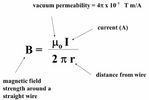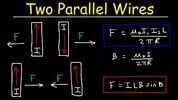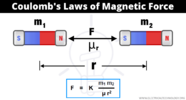BinaryBat2020
- Nov 8, 2022
- 1
- Joined
- Nov 8, 2022
- Messages
- 1
So basically I’m trying to create my own electromagnets and conduct my own experiments. I’ll have an arduino microcontroller send a current into the wire that is coiled around the magnet, thus increasing the strength of the magnetic field, which in turn will touch with other magnets. I want to know how much force is required and at what distance apart to get two electromagnets to be attracted and touch one another. That’s it in a nutshell. That’s what I’m trying to experiment with. I’ve read that a lot of the data with regards to forces between magnets can be derived empirically, so I only need to know the basics.
This is what I have found to calculate the strength of a magnetic field with a current carrying wire.

But when it comes to calculating the force between 2 magnets, I find two different things…
One is the force between 2 current carrying wires...

Another is a law called Coulomb's Law...

It seems to me that these 2 formulas are trying to find the same thing; The force between two magnets. A current carrying wire essentially is a magnet because it produces its own magnetic field. Yet the formulas are different and I don’t know which one to use. Am I wrong? I’m not sure.
What formulas will I need to know to conduct the type of experimentation that I am looking for? There’s so much information out there that I’m not sure where to start. All I want is to apply different currents and have magnets touch each other, and to be able to calculate within a general range of how much force will be needed to do such.
I hope this is not too vague. Any feedback will be greatly appreciated thx. If there are any guides out there for experimenting with electromagnets or any resources that you think would be helpful to me plz link them below.
This is what I have found to calculate the strength of a magnetic field with a current carrying wire.

But when it comes to calculating the force between 2 magnets, I find two different things…
One is the force between 2 current carrying wires...

Another is a law called Coulomb's Law...

It seems to me that these 2 formulas are trying to find the same thing; The force between two magnets. A current carrying wire essentially is a magnet because it produces its own magnetic field. Yet the formulas are different and I don’t know which one to use. Am I wrong? I’m not sure.
What formulas will I need to know to conduct the type of experimentation that I am looking for? There’s so much information out there that I’m not sure where to start. All I want is to apply different currents and have magnets touch each other, and to be able to calculate within a general range of how much force will be needed to do such.
I hope this is not too vague. Any feedback will be greatly appreciated thx. If there are any guides out there for experimenting with electromagnets or any resources that you think would be helpful to me plz link them below.
